Capital of Alaska ( administrative center state): Juneau
Official name: State of Alaska (AK)
Most Big City:
Anchorage 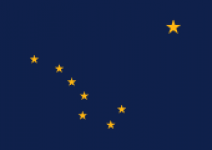
Other major cities:
Kodiak Fairbanks, College, Barrow, Homer, Seward, Cordova.
State nicknames: The Last Frontier
State motto: North to the Future
State formation date: 1959 (49th in order) 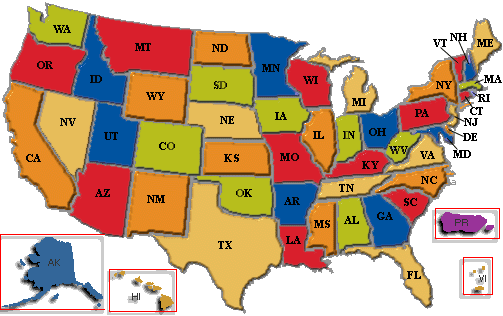
The name of the state of Alaska comes from the language of the native inhabitants of the Aleutian Islands - the Aleuts. "Alaska" is a distorted Aleutian word Alakshak meaning " big land"(Or" that which blocks the sea "," peninsula ").
Alaska (Alaska) - the largest state in the United States, on the northwestern outskirts North America... Includes the peninsula of the same name, Aleutian Islands, a narrow strip pacific coast together with the islands of the Alexander archipelago along western Canada and the mainland.
To the west, Alaska borders the Chukotka Autonomous Region Russian Federation along the Bering Strait, in the east, the state borders on Canada. The state has access to two oceans - the Arctic and Pacific oceans.
State population
Although the state is one of the least populated in the country, many new residents moved here in the 1970s, attracted by vacancies in oil industry and in transport, and in the 1980s, population growth was over 36 percent.
The largest ethnic (national) groups among the population of Alaska
- Germans - about 20%
- Irish - about 13%
- British - about 11%
- Norwegians - about 4.5%
- French - about 3.5%
- Scots - about 3%
Alaska has the highest percentage of Aboriginal people in the United States. Eskimos, Aleuts, Inuipaks and many other peoples live here.
State history
The earliest settlers of the Alaskan lands are the Eskimo and Aleut tribes. The first Europeans to visit Alaska were the Russian crew of the Saint Gabriel ship on August 21, 1732, under the leadership of M. S. Gvozdev and the navigator I. Fedorov. From 1799 to 1867, Alaska was operated by the Russian-American Company.
Alaska lands became part of the United States in 1867, when Russian empire sold this shore to the Union American states... On the American side, this sales agreement was signed by Senate Secretary William H. Seward. Under this agreement, the United States paid $ 7.2 million for the land in Alaska.
At the end of the 19th century, gold was found in Alaska, which gave rise to the famous "gold rush", and the word Klondike became a household name. The gold rush swept the continent, and thousands of thousands of prospectors flocked to Alaska hoping to find gold on these lands and get rich. A few years later the excitement subsided, but the people who had settled in these lands by that time did not leave Alaska.
From 1940 to 1950, a huge influx of foreign immigrants to Alaska lands contributed to the industrial revival and development of these lands. On January 3, 1959, Alaska became part of the United States as an independent state - the 49th state.
State landmarks

Signing of the agreement to sell Alaska.
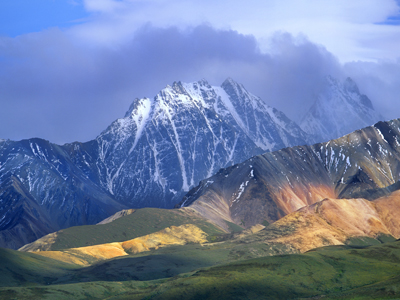
Alaska is a land of primeval, wild beauty of Nature. Rugged by fjords, and soaring up to the clouds with the enchanting beauty of snowy mountains.
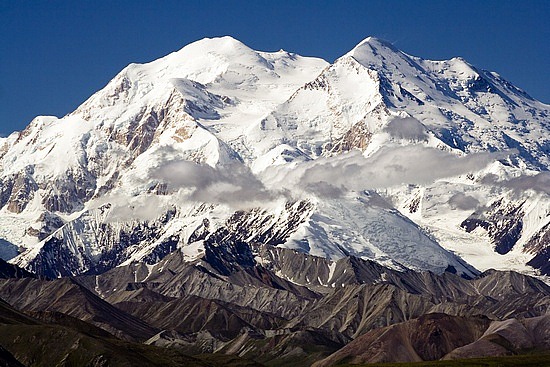
The highest point in North America is Mount McKinley in Alaska
![]()
Volcano Redout is active volcano Alaska. 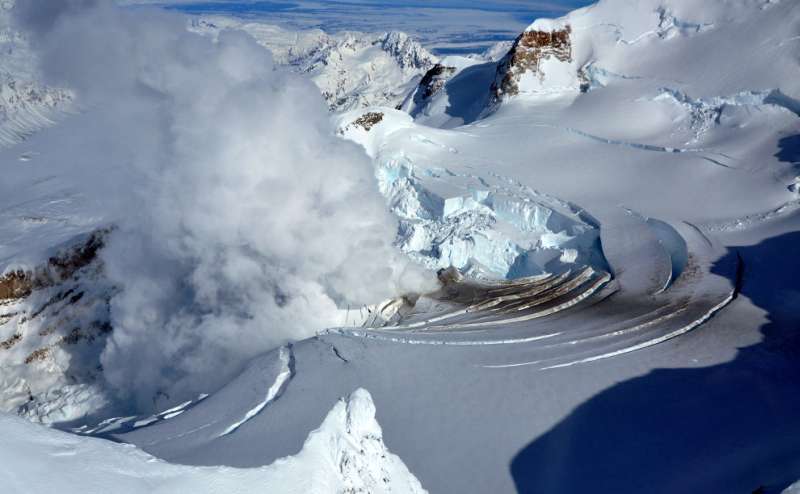
Eruption 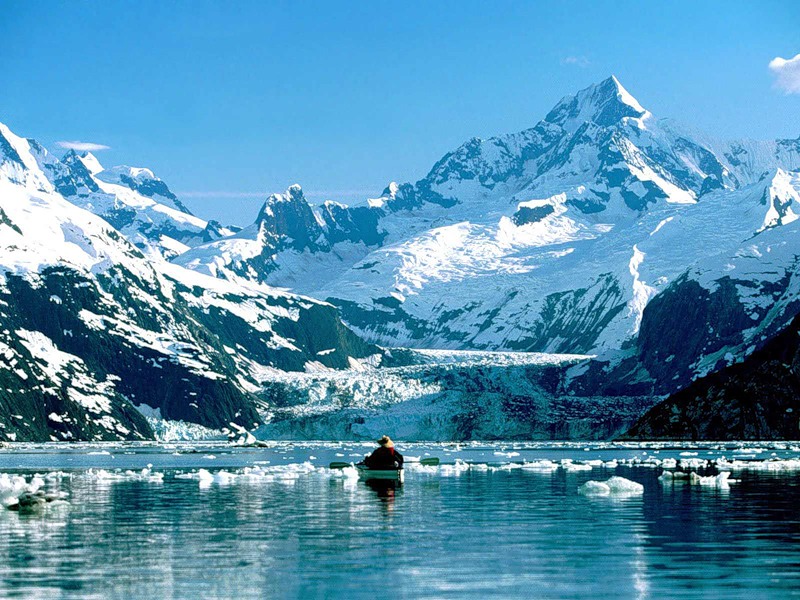
Alaska is a kingdom of natural contrasts: piercing winds and scorching sun, rain and snow, heat and cold. Alaska is a land that is still subject to global tectonic changes in the landscape. 
Northern Lights over Circle (Alaska) 
Denali National Park 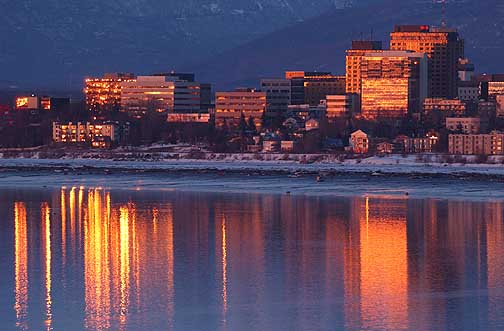
Largest city - Anchorage<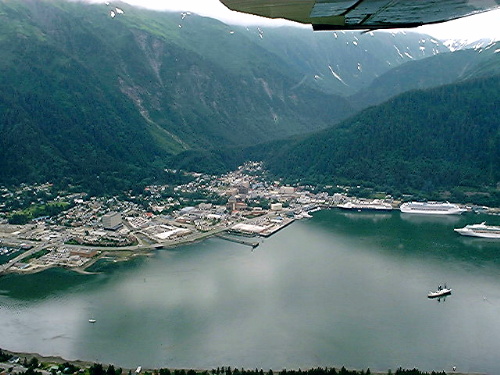
Juneau, the current capital of Alaska, is rightfully recognized as the most original of all 50 state capitals. 
St. Nicholas Church in Juneau - the capital of Alaska 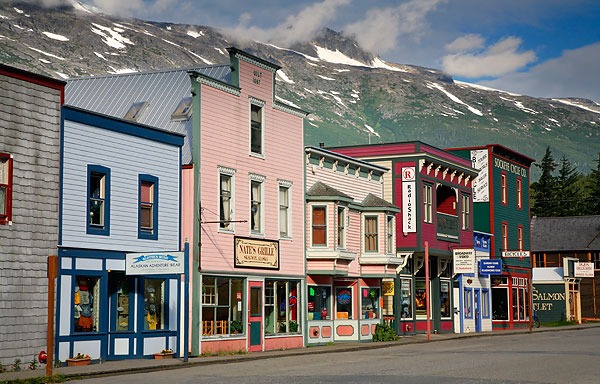
Skagway is the capital of the Gold Rush. Skagway is a quiet, well-kept town 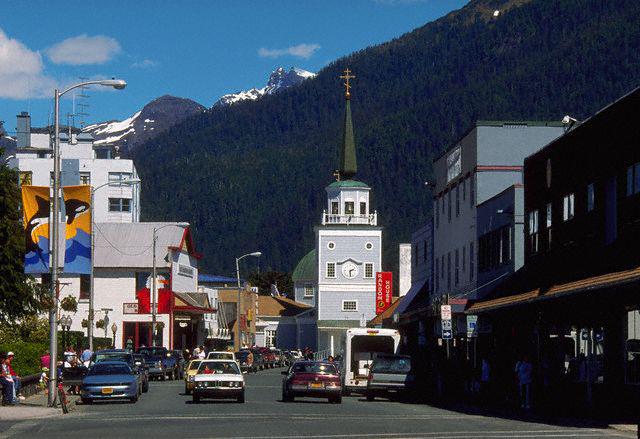
Sitka is the former capital of "Russian Alaska." 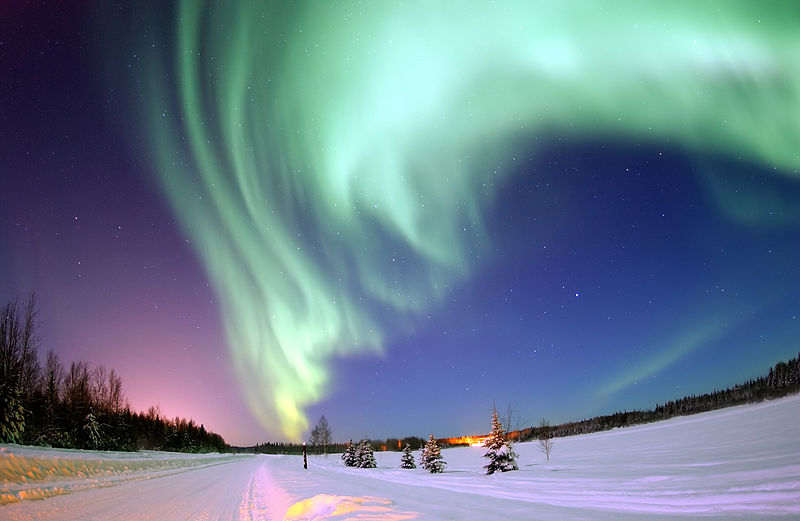
USA, Alaska, Aurora
■ The Alaska flag was created by a 13-year-old boy.
■ The first settlement in Alaska was founded on Kodiak Island in 1784 by Russian fur traders and whalers.
■ Alaska was sold to the United States in 1867 for just over $ 100 million today. 30 years after the sale, gold deposits were discovered there and the famous "gold rush" began, and in the 20th century large oil and gas fields were discovered with total reserves of $ 100-180 billion.
■ At the same time, New York State was buying ownership of a courthouse that was more expensive than Alaska. And at the current exchange rate, Alaska was sold for about $ 4 per hectare with all the buildings and subsoil.
Funny Alaska Laws
■ In Fairbanks, it is illegal to drink alcoholic beverages to moose.
■ While it is permitted to shoot bears, it is forbidden to wake them up to take pictures.
■ You cannot observe moose from an airplane.
■ It is a crime if you push a live moose out of the plane.
And for fans of the mysteries of history, I am posting this article.
E.P. TOLMACHEV
Alaska We Lost
“The editors have received several letters from their readers in America. Here they are:
Hello!
Many Americans ask me about the sale of Alaska, and when I say that Alaska was loaned for 100 years and was not returned to Russia, they are all indignant. When I was still studying at the teacher's college, the history teacher told us that there are documents confirming the fact of renting Alaska. I myself have not seen any documents. I inquired here in America, and all I could find was the announcement of the American president about the purchase of Alaska. Where is the truth? Did Tsar Alexander sell or lease Alaska?
Maybe some of your authors will find time to answer this question? Believe me, I have been trying for several days to find the answer myself, but I have not been able to find any Russian sources.
Thanks in advance, Oksana Shiel, USA.
... I asked the question in an Internet conference, where about 1.5 thousand or so people participate, to one degree or another connected with partners from the former Soviet Union ... Only 25 found it possible to answer this question and one third of them seriously believe that Alaska was leased.
From a letter to the editor, Richard L. Williams, USA.
We turned to Doctor of Historical Sciences E.P. Tolmachev with a request to tell the story of the sale of Alaska and received his kind consent.
Editorial staff
It has already been noted more than once that the discovery and development of America was not a one-off event, but a long-term and complex process.
As Academician N.N.Bolkhovitinov justly noted, the American continent was discovered and explored by representatives of different countries and peoples, just as outer space is now being studied by international efforts. It is no coincidence that New England, New Spain, New France once existed on the territory of North America ... Our country has the honor of discovering this continent from the East, from Asia.
As a result of the numerous voyages of Russian sailors, explorers, entrepreneurs, in the 18th century Asia "converged" with America and permanent and strong contacts were established between the two continents. Russia has become not only a European and Asian, but, to some extent, an American power. The term "Russian America" appeared and later won the rights of citizenship, which united Alaska, part of Northern California, the Aleutian Islands.

G.I. Shelikhov
The first Russian settlement in North America was founded by the merchant-entrepreneur G.I. Shelikhov in 1784 on Kodiak Island. Novo-Arkhangelsk, founded in 1799, which received this name in 1804, and later renamed Sitka, became the administrative center of Russian settlements in America.
On July 8, 1799, by the decree of Paul I "under the highest patronage" for the development of Russian lands in America and on the adjacent islands, a trade association was created - the Russian-American Company (RAC). N.P. Rezanov was one of its founders and first directors. With the support of the Russian government, the company founded many settlements, took an active part in the development of Sakhalin and the Amur region. She organized 25 expeditions (15 round the world; the most famous and largest - I.F. Kruzenshtern and Yu.F. Lisyansky), carried out significant research work in Alaska. The company's activities were, on the whole, ambivalent. Predatory fur trade and, at the same time, assistance in the introduction of arable farming, cattle breeding and truck farming in a number of regions.
Since the beginning of the XIX century. The activities of the Russian-American company were complicated by the struggle against British and American entrepreneurs who armed the natives to fight against the Russians and who sought to liquidate Russian settlements in America.
The Russian-American Convention, adopted on April 5, 1824 in St. Petersburg, established the border of Russian settlements and industries. The Russians pledged not to settle to the South, and the Americans - to the North, parallel to 54 ° 40 ′ N. In an effort to maintain friendly relations with the United States, St. Petersburg made concessions: fishing and sailing along the American coast in the Pacific Ocean were declared open to ships of both countries for 10 years.
N.P. Reza 
The convention caused obvious discontent among the management of the Russian-American company. The Americans, on the other hand, greeted the conclusion of the Convention with satisfaction. However, the ruling circles of America and the developing bourgeoisie did not stop the expansionist policy in the North Pacific Ocean, which was ultimately one of the reasons for the sale of Alaska by Russia in 1867.
A similar convention was signed with England on February 28, 1825: it defined the southern borders of Russian possessions on the same parallel.
It is believed that both conventions meant unilateral concessions on the part of Russia and the beginning of its retreat from North America.
Aggravation of Russian-English relations
During the Crimean War, the US government, using the aggravation of Russian-British relations in the Middle East, offered Russia to buy Alaska from it. Petersburg rejected this offer. As the modern historian V.N. Ponomarev notes, the anxiety of the administration of the RAC and the Americans, inspired by the truth of different motives, was a prerequisite for the appearance of a fictitious agreement on the sale of Russian America. The text of the document stated that it was signed on May 19, 1854 on behalf of the RAC by P.S. Kostromitinov, who, while holding the post of the Russian vice-consul in San Francisco, was also an agent of this company; on the other hand, the document was signed by A. McPherson, a representative of the Californian American-Russian Trading Company (ARTC). In accordance with the agreement, the first party (i.e. the RAC) ceded to the second (ATRC) for a period of three years all its property, trades and privileges in North America. The second party, in turn, undertook to pay the first party 7 million 600 thousand dollars. It is interesting that this amount almost coincides with that (7 million 200 thousand), for which Russian America was sold in 1867.
The purpose of the fictitious treaty was to force the British to abandon the attack on the territory of Russian possessions. In the event of an attack, a new conflict would inevitably arise between Britain and the United States, which, given the already tense Anglo-American relations, was undesirable for Albion. In the opinion of the authors, and primarily of Kostromitinov, it should have come into force only if absolutely necessary.
The idea of a possible sale of Russian America to the United States after the end of the Crimean War was further developed.
Russian envoy to Washington E.A. Glass
The main supporter of the sale of Alaska was the head of the Naval Ministry, Grand Duke Konstantin Nikolaevich, who in the spring of 1857 sent a special letter to the Minister of Foreign Affairs A.M. Gorchakov on this matter. The Grand Duke's proposal was subsequently supported by Admiral E.V. Putyatin, Captain 1st Rank I.A. Shestakov and the Russian envoy to Washington E.A. Glass.
Although the US government considered this purchase very profitable, it offered only $ 5 million for Russian possessions, which, according to A. Gorchakov, did not reflect the "real value of our colonies."
The American Civil War, which began in April 1861, delayed the development of negotiations on this issue. The sympathies of the Russian government and the public were on the side of the North, which fought for the elimination of slavery.
In 1862, the French government proposed to England and Russia to implement diplomatic intervention in the struggle between North and South on the side of the Southerners. Alexander II refused this, which prevented the entry of the European powers into the civil war. The Emperor well remembered how, during the Crimean War, the United States openly declared its friendly relations with Russia. At the same time, they revived the trade, supplying weapons and equipment to the belligerent army. In addition, the United States reported on the advance of enemy ships and was even ready to send volunteers.
In an atmosphere of political excitement raised in 1863 by France, England and Austria over the Polish question, the Russian government, in agreement with the US government, took retaliatory steps.
Two squadrons were sent to the territorial waters of the United States: the squadron of Rear Admiral S.S. Lesovsky (3 frigates, 2 corvettes and 3 clippers) arrived in New York in July 1863, and the squadron of Rear Admiral A.A. Popov ( 5 corvettes and 4 clippers) in October 1863 - in San Francisco.
Military actions and maneuvers
In the event of a war with Great Britain and France, the Russian fleet was supposed to protect the coast of the United States from a possible enemy attack and strike at its distant communications and colonies. The unexpected appearance off the coast of the United States of Russian ships, enthusiastically greeted by the Americans, had a great political resonance. There was no end to the receptions, balls and parades in honor of the Russian Navy. In mid-September 1863, America's "first lady", Mary Tod-Lincoln, arrived in New York to visit the admiral's flagship. She was solemnly greeted by Russian sailors and a military band who sang the US anthem and "God Save the Tsar." All the newspapers in America wrote about this celebration. Russian ships provided moral support to the federal government, promoted Russian-American rapprochement, and forced Britain and France to change their stance. Russian squadrons, united in April 1864 in New York, were withdrawn when the troops of the northerners broke the resistance of the Confederation of the South, and in July 1864 left the shores of North America.
It should be noted that Russians, Ukrainians and Poles who emigrated from Russia to the United States fought in the army of the North. Former Colonel of the General Staff IV Turchaninov, who moved to America after the Crimean War, commanded the Illinois volunteer regiment. On June 17, 1862, by decision of President Lincoln, he was promoted to the rank of brigadier general.
Unity of the USA
The failure of the plans of the Anglo-French intervention and the friendly position of Russia contributed to the victory of the North over the South and the restoration of the unity of the United States.
During the war, Secretary of State W. Seward conveyed to St. Petersburg that "the president expressed satisfaction with the reasonable, just and friendly course" pursued by the Russian government. And his Russian counterpart Gorchakov, at the end of the Civil War, emphasized the importance of restoring "the old union, which constituted the strength and prosperity of the American Republic."
The revival of the idea of selling Russian possessions in North America could not but contribute to the end of the Civil War in the United States and the friendly visit of the American squadron led by Assistant Secretary of the Navy G.V. Fox to Russia in the summer of 1866.
The beginning of a new relationship
The immediate reason for the resumption of discussions about the fate of Russian America was the visit to St. Petersburg of the Russian envoy to Washington E.A. Stekl. After leaving the United States in October 1866, he was in the capital until the beginning of the next, 1867, where he had meetings with such key figures as the Grand Duke Konstantin, Foreign Minister Gorchakov and Finance Minister Reitern.
On December 16, 1866, a "special meeting" was held in the ceremonial office of the Russian Foreign Ministry on Palace Square with the personal participation of Alexander II. The meeting was also attended by v.k. Konstantin, Gorchakov, Reitern, Krabbe (head of the Naval Ministry) and Stekl. All participants spoke in favor of the sale of the Russian colonies in North America to the United States, and the departments concerned were instructed to prepare their views for the envoy to Washington.
Several reasons contributed to the decision of the Russian government. By selling Alaska, Russia hoped to maintain a "close alliance" with the United States and postpone everything "that could give rise to disagreement between the two great powers." In the face of the United States in the Pacific, this deal created a counterbalance to England. The purchase of Alaska gave the United States the opportunity to weaken the position of the Canadian Hudson's Bay Company and to squeeze British Columbia in a vice between its possessions.
Karl Marx wrote to F. Engels on March 27, 1867 that by selling Alaska the Russians would "make porridge" to the British in the United States. US relations with England were strained at the time due to the support that London provided to the Southerners during the Civil War.
Capture of Alaska?
Petersburg feared the capture of Alaska by England and, moreover, was unable to protect the Russian possessions in America from the North American tradesmen and smugglers. In addition, the sale of Alaska was due to the unsatisfactory state of affairs in the RAC, the existence of which had to be supported by "artificial measures and monetary donations from the treasury." It was believed that the main attention should be focused on "the successful development of the Amur Territory, where the future lies in the Far East for Russia."
On his return to Washington in March 1867, Steckle reminded Secretary of State Seward "of the offers that have been made in the past for the sale of our colonies," and declared that the Russian government was now "disposed to negotiate."
The treaty on the sale by Russia of Alaska (Russian America) to the USA was signed on March 18, 1867 in Washington by the Secretary of State Seward and the Russian envoy Steckle. According to the agreement, the United States acquired from Russia Alaska with the nearby Aleutian Islands for an insignificant amount - 7 million 200 thousand dollars (11 million rubles), having received an area of 1519 thousand square meters. km, on the development of which the Russian people have put a lot of effort and money for 126 years. In 1959, Alaska became the 49th US state.
Twenty-five thousand dollars was granted by the king to the messenger. More than one hundred thousand dollars was written off by St. Petersburg under a secret expense item "on matters known to the emperor." (Steckl had to bribe editors for newspaper support, politicians for speeches in Congress.)
On May 3, 1867, the treaty was ratified by Alexander II. On June 8 of the same year, an exchange of instruments of ratification took place in Washington.
Russian society did not immediately grasp the essence of the deal. The newspaper Golos, which had a reputation for being "official", was indignant: "Is it possible that foreigners should take advantage of the works of Shelikhov, Baranov, Khlebnikov and other selfless people for Russia and collect their fruits?" Some US politicians also reacted ambiguously to the purchase of Russian America. Most newspapers have launched a "frenzied campaign" against the treaty, claiming that Alaska is wild and useless, a polar bear zoo. "
Transfer of Alaska
The official ceremony of transferring Alaska to the United States took place in Novo-Arkhangelsk on October 6, 1867. An American military detachment (250 people), led by General L. Russo, and Russian soldiers ( 100 people) under the command of Captain A.I. Peshchurov. After the announcement of the US treaty with Russia and a 42-shot salute, the Russian flag was lowered and the American Stars and Stripes were raised.
The acquisition of Russian America strengthened the position of the United States in the northeastern Pacific Ocean, greatly facilitating its further expansion in this region.
But the saddest thing in this whole story is that the money for Alaska never made it to Russia. A significant part of the $ 7.2 million was paid in gold, which was loaded onto the Orkney ship, heading for St. Petersburg. In the Baltic Sea, a group of conspirators tried to seize the gold, but failed. And the ship for some reason sank along with the precious cargo ... "
Athabasca
Unlike the inhabitants of the coast, who had their own rich natural resources, representatives of the peoples of the Athabasca language group lived in more severe conditions of the Arctic and Subarctic in the north of the continent. This vast space had extremely poor natural conditions, and people had to find with great difficulty and find food for themselves. The weather conditions in this region have always been characterized by long winters and short cold summers. The Atthabasca Indians hunted for elk, musk deer, grizzly bear, wild goats and were engaged in fishing.
The Athabascans led a nomadic or semi-nomadic lifestyle, moving from one region to another in search of prey for hunting and fishing. In the rivers they fished for trout and pike, in the forests they hunted mainly musk deer, hares and polar partridges. The tools for hunting and fishing were used the same as all the Indians of the North American continent. And although the Athabascans hunted a lot of animals and birds, however, periods when their tribes were starving were not uncommon in the life of the Athabascans.
They designed the construction options for their wigwam houses depending on the coming season. All Athabascans built their houses of wood and poles so that, in addition to the family, pets and birds could also fit in them. Nomadic groups of Indians built lighter dwellings. Indians of such tribes of the Athabasca people as Ingalik ( Ingalik ) who lived on the Yukon River or the Kaskokwim tribe ( Kuskokwim ) usually for the winter they built a temporary settlement, and for summer fishing they moved to bivouacs - "camps". They built winter houses on the principle of Eskimo dugouts.
The Athabascans had very simple social divisions of society. They spent most of the year with small groups of neighboring families. The similarity between them existed in the fact that they professed the principles of matriarchy and relatives maintained close relations, observing all the obligations of members of the same family. A family member had to find a spouse not among close relatives, but in another tribe.
When natural resources allowed, several tribes united to hunt together. Despite the fact that they all hunted together, the male Indians competed with each other for the right to be the leader in the hunt, on the basis of which a man could become one of the leaders of the tribe. Also, an Indian who showed himself as a brave warrior in tribal conflicts could become the leader of the tribe. Leaders were not elected for life. And if once luck turned away from the leader, he could no longer claim leadership in the tribe. The Athabascans had traditions and ceremonies, in which, for example, the tribe met and presented gifts to its guests. Also, a family meal was arranged when one of the members of the tribe died. When the Athabascans began to participate in trade exchanges with the "palefaces", they began to more often arrange tribal meals in honor of their new partners, thereby simulating attitudes and traditions of attitudes towards "palefaces" for the tribes of the entire northwestern coast of the American continent.
The Indians held feasts to commemorate the first hunt, military feat, the return of hunters from a long campaign, a successful revenge or a new campaign. A man about to marry had to arrange a feast for his tribe three times. Also, ceremonies were arranged when the tribe made a general decision to expel one of its members for offense - he could not receive any support from any of his relatives for at least one year. The Athabascans were also pagans. They lived in a world inhabited by many spirits. They believed that after death, human souls migrate to animals and used these legends in their rituals.
The Athabascans had special tribal members who performed religious rituals and were responsible for connecting the Indians with the world of otherworldly forces. These people were called shamans. Shamans were the keepers of religious rites and possessed many knowledge: how to heal a sick person; how to attract good luck to a hunter; how to predict the weather and the future.
Eskimos
The Eskimo culture developed in the territories of western Alaska, so it is natural that the languages of the Eskimos and Aleuts are so different from each other. The Eskimos mastered the waters of the Arctic Ocean and therefore paid great attention to the means of water transportation. The traditional tools of the Eskimo economy were in use on the territory of Siberia long before their appearance on the lands of Alaska. And this culture and management technologies penetrated the territory of North America and 4 thousand years BC. spread from Alaska to Greenland.
From the shores of northern Alaska to Greenland, the Eskimos hunted sea animals: seals, seals, whales. Some groups of Eskimos hunted deer and musk deer. These groups of the Eskimo people were called the Eskimos Caribou ( Caribou eskimo ) and lived in Canada, in the west of the Hudson Bay. Other small groups of the Eskimo people lived along the Colville rivers ( Colville and Noatak ), as well as in the delta of the Yukon and Kaskokwim rivers ( Kuskokwim).
However, despite the difference in habitats, the Eskimos had a common culture, national dress and traditions. This happened because thousands of years ago the wild, primitive culture of this nation: dog sleds, kayak boats, and more. others - spread through Alaska throughout the territory North America before Greenland.
Social relations among the Eskimos were centered around the clan family. The men hunted. Eskimos Yupik ( Yupik Eskimo ) had special ceremonial houses in which Eskimo men taught boys the art of hunting, and women sat at home and raised girls. Most Eskimo marriages took place within the tribal community.
Eskimos hunted and fished. They had their own taboos and prohibitions: for example, they did not dare to mix earth and sea animals for food. Eskimos of the Bering Sea ( Bering sea eskimo ) had many rituals and ceremonies associated with hunting animals. And the Eskimos who lived north of their territories did not have similar hunting and fishing traditions. Sea Eskimo) had many rituals and rituals associated with hunting animals. And the Eskimos who lived north of their territories did not have similar hunting and fishing traditions.
Aleuts
The Aleuts have adapted very well to life in the difficult natural conditions of the Aleutian Islands. They have learned to make excellent use of the rich resources of the sea for life. However, their traditions were forgotten and absorbed by the more civilized culture of the Russian people, with whom the Aleuts first met in 1740. The Aleuts built separate dugouts in which they lived with their families. Sometimes the Aleuts wandered to the northern shores of the Bering Sea. This happened when populations of marine animals migrated to other areas. Then the Aleuts built seasonal houses and seasonal camps.
Society was divided into social classes: leaders, common people, and slaves. The traditions of the Aleuts largely overlap with the customs of the Tlingit tribe and groups of peoples of Siberia. It is possible that initially the Aleuts also professed the family principle of organizing the tribe. The Aleutian community usually consisted of an elder father and his wife or wives, a married eldest son and his family, and sometimes a younger brother and his family. Small children were usually sent to be raised by their mothers, who had their own homes.
When the sea waters were cleared of ice, the Aleuts went out to sea to hunt. They hunted seals, walruses, sea lions and whales. Many of their hunting tools were similar to those of the southern Eskimos: a two-seater kayak boat; bone and stone weapons. The Aleuts also hunted birds, 140 species of which nested on the Aleutian Islands. To hunt birds, the Aleuts used bolos (ropes, to the ends of which stones were tied, braided in braids and darted at the birds) In fishing, they used nets and harpoons. Also, the Aleuts collected sea mollusks and northern berries and herbs.
Alaska is the largest state in the United States, on the northwestern edge of North America. It includes the peninsula of the same name, the Aleutian Islands, a narrow strip of the Pacific coast together with the islands of the Alexander archipelago along western Canada and the continental part.
The state is located in the extreme northwest of the continent, separated from the Chukotka Peninsula (Russia) by the Bering Strait, in the east it borders on Canada. Consists of the mainland and a large number of islands: the Alexander archipelago, the Aleutian Islands, the Pribilov Islands, the Kodiak Island, the St. Lawrence Island. It is washed by the Arctic and Pacific oceans. On the Pacific coast - the Alaska Ridge; the inner part - a plateau with a height of 1200 m in the east to 600 m in the west, turns into a lowland.In the north is the Brooks Ridge, behind which is the Arctic Lowland.
| Flag | Coat of arms | Map |
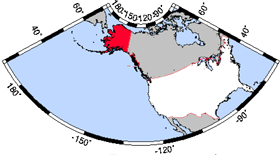
|
Mount McKinley (Denali) (6194 m) is the highest in North America. There are active volcanoes. There are glaciers in the mountains (Malespin).
In 1912, a volcanic eruption created the Valley of Ten Thousand Smokes. The northern part of the state is covered by tundra. Forests are located to the south. The state includes the Little Diomede Island in the Bering Strait, located 4 km from the Great Diomede Island (Ratmanov Island), which belongs to Russia.
On the Pacific coast, the climate is temperate, maritime, relatively mild; in other regions - arctic and subarctic continental, with severe winters.
The famous Denali National Park is located in the vicinity of the highest mountain in the USA, McKinley.
The largest city in Alaska is Anchorage.
The capital of Alaska is Juneau.
Unlike most other states in the United States, where the main lower administrative unit of local government is the county, the name of the administrative units in Alaska is baro (borough). More importantly, another difference is that 15 baros and the municipality of Anchorage cover only part of Alaska. The rest of the territory does not have enough population (at least interested) to form local self-government and forms the so-called unorganized baro, which for the purposes of the population census and for the convenience of management was divided into the so-called census areas. There are 11 such zones in Alaska.
Groups of Siberian tribes crossed the isthmus (now the Bering Strait) 16 - 10 thousand years ago. The Eskimos began to settle on the Arctic coast, the Aleuts settled in the Aleutian archipelago.
Discovery of Alaska
In Western tradition, it is believed that the first white person to set foot on the land of Alaska was G.V. Steller. Bernhard Grzimek's book From Cobra to Grizzly Bear says that Steller was the first to notice the mountainous outlines of the Alaskan Islands on the horizon, and he was eager to continue his biological research. However, the captain of the ship V. Bering had other intentions and soon ordered to wean anchor and return. Steller was extremely outraged by this decision and in the end insisted that the ship's commander give him at least ten hours to survey Kayak Island, where the ship still had to dock to replenish fresh water supplies. Steller titled an article about his exploratory feat-foray "A Description of Plants Collected in 6 Hours in America."

However, in fact, the first Europeans who visited Alaska were on August 21, 1732, members of the team of the Saint Gabriel bot under the command of the surveyor M. S. Gvozdev and the navigator I. Fedorov during the expedition of A. F. Shestakov and D. I. Pavlutsky 1729 -1735 In addition, there is fragmentary information about Russian people visiting America in the 17th century.
Russian America and the sale of Alaska
From July 9, 1799 to October 18, 1867, Alaska with the adjacent islands was under the control of the Russian-American Company. However, after serfdom was abolished in Russia in order to pay compensation to the landowners, Alexander II was forced in 1862 to borrow 15 million pounds from the Rothschilds at 5% per annum. However, the Rothschilds had to return something, and then the Grand Duke Konstantin Nikolaevich - the Tsar's younger brother - offered to sell "something unnecessary." The most unnecessary thing in Russia turned out to be Alaska.
In addition, the hostilities in the Far East during the Crimean War showed the absolute insecurity of the eastern lands of the Empire, and especially Alaska. In order not to lose in vain, it was decided to sell the territory that could not be protected and developed in the foreseeable future.
On December 16, 1866, a special meeting was held in St. Petersburg, which was attended by Alexander II, Grand Duke Konstantin Nikolaevich, the finance and naval ministers, as well as the Russian envoy to Washington, Baron Eduard Andreevich Stekl. All participants approved the sale idea. At the suggestion of the Ministry of Finance, a threshold was set for the amount - at least $ 5 million in gold. On December 22, 1866, Alexander II approved the border of the territory. In March 1867, Steckle arrived in Washington and formally addressed Secretary of State William Seward. The signing of the treaty took place on March 30, 1867 in Washington. Territory with an area of 1 million 519 thousand square meters. km was sold for $ 7.2 million in gold, that is, at $ 0.0474 per hectare.
Alaska as a US state
When did Alaska become a US state? Since 1867, Alaska has been under the jurisdiction of the United States Department of War and was called the District of Alaska, in 1884 - 1912. district, then territory (1912 - 1959), since 1959 - the state of the United States.
Five years later, gold was discovered. The region developed slowly until the onset of the Klondike Gold Rush in 1896. During the years of the gold rush in Alaska, about one thousand tons of gold was mined.
Alaska was declared a state in 1959. Various mineral resources have been exploited there since 1968, especially in the Prudhoe Bay area, southeast of Point Barrow. In 1977, an oil pipeline was laid from Prudhoe Bay to the port of Valdez. In 1989, an oil spill from the Exxon Valdez tanker caused serious environmental pollution.
In the north, crude oil production (in the area of Prudhoe Bay and the Kinai Peninsula; the Alieska oil pipeline, 1250 km long to the port of Valdez), natural gas, coal, copper, iron, gold, zinc, fishing, reindeer breeding; logging and hunting, air transport, military air bases.
Oil production has played a huge role since the 1970s. after the discovery of deposits and the laying of the Trans-Alaska pipeline. The Alaska oil field has been compared in importance to the oil fields in Western Siberia and the Arabian Peninsula.
Population
Although the state is one of the least populated in the country, many new residents moved here in the 1970s, attracted by jobs in the oil industry and transportation, and in the 1980s the population grew by more than 36 percent.
Population growth in recent decades:
1990 - 550,000 inhabitants;
2004 - 648 818 inhabitants;
2005 - 663 661 inhabitants;
2006 - 677 456 inhabitants;
2007 - 690 955 inhabitants.
In 2005, the population of Alaska increased over the previous year by 5906 people, or 0.9%. Compared to 2000, the population increased by 36,730 people (5.9%). This includes a natural increase in the population of 36,590 (53,132 births minus 16,542 deaths) since the last census, as well as an increase due to migration by 1,181. Immigration from outside the United States increased the population of Alaska by 5,800, while internal migration reduced it by 4,619. Alaska has the lowest population density of any state in the United States.
About 75 percent of the population is white, US-born. The state has about 88,000 indigenous people - Indians (Athapaski, Haida, Tlingit, Simshian), Eskimos and Aleuts. There are also a small number of Russian descendants living in the state. Major religious groups include Catholics, Orthodox Christians, Presbyterians, Baptists, and Methodists. The share of Orthodox Christians, according to various estimates, 8-10%, is the highest in the country.
For the past 20 years, residents of the state have traditionally voted for Republicans. Former Republican Governor Sarah Palin was a runner-up for US Vice President in the 2008 elections under John McCain. Currently Governor Sean Parnell.
Alaska(eng. Alaska[əˈlæskə], eskim. Alaskaq, Aqłuq) - the northernmost and largest state in terms of territory; located in the northwest. In the Bering Strait it has a sea border with.
It includes the peninsula of the same name with adjacent islands, the Aleutian Islands, a narrow strip of the Pacific coast, together with the islands of the Alexander archipelago along the western border.
The area of the territory is 1 717 854 km², of which 236 507 km² falls on the water surface. Population - 736 732 people. (2014). The state capital is a city.
Etymology
The name comes from Aleutian alasҳaҳ- "whale place", "whale abundance". Initially, only the southwestern part of the territory of the present state (Gulf of Alaska, Alaska Peninsula) was called Alaska. The name has been fixed since the 18th century.
Symbolism
The flag of Alaska was invented by thirteen-year-old Benny Benson from Chignik. Eight five-pointed stars are depicted on the blue background of the flag: seven of them symbolize the constellation Ursa Major, and the eighth - the Pole Star.
Geography
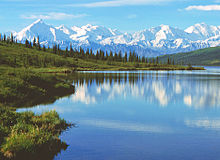
Typical Alaskan Scenery (Wonder Lake, Denali National Park)
The state is located in the extreme northwest of the continent, separated from the Chukotka Peninsula () by the Bering Strait, in the east it borders on, in the west on a small section of the Bering Strait - with Russia. Consists of the mainland and a large number of islands: the Alexander Archipelago, the Aleutian Islands, the Pribilov Islands, the Kodiak Island, the St. Lawrence Island. It is washed by the Arctic and Pacific oceans. On the Pacific coast - the Alaska Ridge; the inner part is a plateau with a height of 1200 m in the east and up to 600 m in the west; passes into the lowlands. In the north is the Brooks Ridge, behind which is the Arctic Lowland.
Mount Denali (6194 m, formerly McKinley) is the highest in. The famous Denali National Park is located in its vicinity.
There are active volcanoes.
In 1912, a volcanic eruption created the Valley of Ten Thousand Smokes and the new volcano Novarupta. The northern part of the state is covered by tundra. Forests are located to the south. The state includes the island of Kruzenshtern (Small Diomede) in the Bering Strait, located at a distance of 4 km from Ratmanov Island, which belongs to Russia.
On the Pacific coast, the climate is temperate, maritime, relatively mild; in other areas - arctic and subarctic continental, with severe winters.
Largest cities
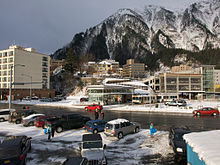
Administrative division
Unlike most other states in the United States, where the main local administrative unit of local government is the county, the name of the administrative units in Alaska is borough. More importantly, another difference is that 15 boroughs and the municipality of Anchorage cover only part of Alaska. The rest of the territory does not have enough population (at least interested) for the formation of local self-government and forms the so-called unorganized borough, which for the purposes of the population census and for the convenience of management was divided into the so-called population census zones. There are 11 such zones in Alaska.
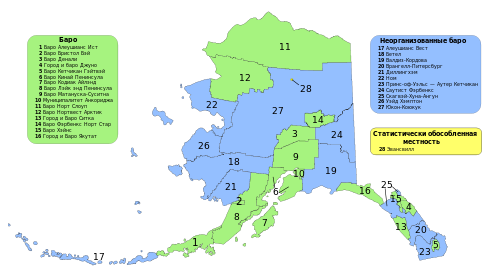
Administrative divisions of Alaska
List of all administrative divisions of Alaska(In alphabet order):
- Bristol Bay
- Eastern Aleutian Islands
- Denali
- Kodiak Island
- Kenai
- Ketchikan Gateway
- Lake and Peninsula
- Matanuska-Susitna
- North Slope
- Northwest Arctic
- Fairbanks North Star
- Haynes
- Yakutat
- Unorganized boroughs:
- Bethel
- Valdez-Cordova
- Dillingham
- Western Aleutian Islands
- Petersburg
- Prince of Wales - Hyder
- Wade Hampton
- Huna - Angun
- Southist Fairbanks
- Yukon-Koyukuk
- Independent cities:
History
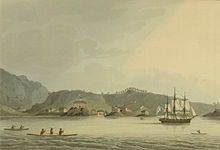
Sloop "Neva" in the harbor of St. Paul on the island of Kodiak
Groups of Siberian tribes crossed the isthmus (now the Bering Strait) 16-10 thousand years ago. The Eskimos began to settle on the Arctic coast, the Aleuts settled in the Aleutian archipelago.
Opening
The first Europeans to visit Alaska on August 21, 1732 were members of the St. Gabriel "under the supervision of the geodesist M. S. Gvozdev and the navigator I. Fedorov during the expedition of A. F. Shestakov and D. I. Pavlutsky in 1729-1735. In addition, there is fragmentary information about Russian people visiting America in the 17th century.
Sale
From July 9, 1799 to October 18, 1867, Alaska with the adjacent islands was under the control of the Russian-American Company. The fighting in the Far East during the Crimean War showed the absolute insecurity of the eastern lands of the Russian Empire, and especially Alaska. In order not to waste the territory that could not be protected and developed in the foreseeable future, it was decided to sell it.
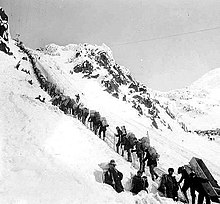
Gold prospectors and miners climb a trail across the Chilkut Pass during the Klondike Gold Rush
On December 16, 1866, a special meeting was held, which was attended by Alexander II, Grand Duke Konstantin Nikolaevich, the finance and naval ministers, as well as the Russian envoy to the Baron Eduard Andreevich Stekl. All participants approved the sale idea. At the suggestion of the Ministry of Finance, a threshold was set for the amount - at least $ 5 million in gold. On December 22, 1866, Alexander II approved the border of the territory. In March 1867, Steckle arrived in Washington and formally addressed Secretary of State William Seward.
The signing of the agreement for the sale of Alaska took place on March 30, 1867 in Washington. The territory with an area of 1.519 thousand km² was sold for 7.2 million dollars in gold, that is, at 4.74 dollars per km² (the much more fertile and sunny French Louisiana, bought from France in 1803, cost the US budget a little more - about $ 7 per km²). Finally, Alaska was transferred to the United States on October 18 of the same year, when Russian commissioners headed by Admiral Alexei Peshchurov arrived at the fort. The Russian flag was solemnly lowered over the fort and the American one was raised. On the American side, 250 soldiers in full dress, commanded by General Lavelle Russo, participated in the ceremony, who provided Secretary of State William Seward with a detailed report of the event. Since 1917, October 18 has been celebrated as Alaska Day.
Golden fever
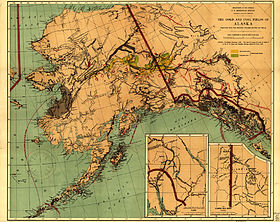
Alaska and British Columbia map of 1897 showing gold deposits
Gold was discovered in Alaska around this time. The region developed slowly until the onset of the Klondike Gold Rush in 1896. During the years of the gold rush in Alaska, about one thousand tons of gold was mined, which in April 2005 prices corresponded to $ 13-14 billion.
New story
Since 1867, Alaska was under the jurisdiction of the US Department of War and was called the "District of Alaska", in 1884-1912 "district", then "territory" (1912-1959), since January 3, 1959 - the state of the United States.
Recent history
Alaska was declared a state in 1959. Various mineral resources have been exploited there since 1968, especially in the Prudhoe Bay area, southeast of Cape Barrow.
In 1977, the Prudho Bay oil pipeline was laid to the port of Valdez.
In 1989, an oil spill from the Exxon Valdez tanker caused serious environmental pollution.
Economy
In the north, extraction of crude oil (in the area of the Prudho Bay and the Kenai Peninsula; the Alieska oil pipeline with a length of 1250 km to the port of Valdiz), natural gas, coal, copper, iron, gold, zinc; fishing; raising reindeer; logging and hunting business; air transport; military airbases. Tourism.
Oil production has played a huge role since the 1970s. after the discovery of deposits and the laying of the Trans-Alaska pipeline. The Alaska oil field has been compared in importance to the oil fields in Western Siberia and the Arabian Peninsula.
In March 2017, the Spanish Oil Company announced its find: 1.2 billion barrels of oil in Alaska. The firm says it is the largest land-based find in the United States in the past 30 years. Oil production in this region is planned for 2021. According to experts' estimates, production volumes will be up to 120,000 barrels of oil per day.
Population
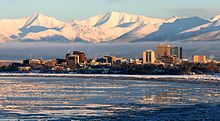
Anchorage
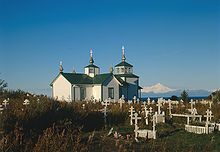
Orthodox church in Unalyaska
Although the state is one of the least populated in the country, many new residents moved here in the 1970s, attracted by jobs in the oil and transportation industries, and in the 1980s the population grew by more than 36 percent.
Alaska population in recent decades:
- 1990 - 560 718 inhabitants;
- 2004 - 648 818 inhabitants;
- 2005 - 663 661 inhabitants.
- 2006 - 677 456 inhabitants.
- 2007 - 690 955 inhabitants.
In 2005, the population of Alaska increased over the previous year by 5906 people, or 0.9%. Compared to 2000, the population increased by 36,730 people (5.9%). This includes a natural increase in the population of 36,590 (53,132 births minus 16,542 deaths) since the last census, as well as an increase due to migration by 1,181. Immigration from outside the United States increased the population of Alaska by 5,800, while internal migration reduced it by 4,619. Alaska has the lowest population density of any state in the United States.
About 75 percent of the population is white, US-born. The state has about 88 thousand indigenous people - Indians (Athapaski, Haida, Tlingits, Tsimshians), Eskimos and Aleuts. The state also has a small number of Russian descendants. Major religious groups include Catholics, Orthodox Christians, Presbyterians, Baptists, and Methodists. The share of Orthodox Christians, according to various estimates, 8-10%, is the highest in the country.
For the past 20 years, residents of the state have traditionally voted for Republicans. Former Republican Governor Sarah Palin was a runner-up for US Vice President in the 2008 elections under John McCain. Sean Parnell is currently the Governor of Alaska.
Languages
According to a 2011 study, 83.4% of people over the age of five speak only English at home. 69.2% speak English “very good”, 20.9% “good”, 8.6% “not very good”, 1.3% “do not speak at all”.
Alaska Language Center University of Alaska Fairbanks claims that there are at least 20 Alaskan Aboriginal languages and their dialects as well. Most of the languages belong to the Eskimo-Aleut and Athabaskan-Eyako-Tlingit macrofamilies, but there are also isolated ones (Haida and Tsimshian).
In some places, dialects of the Russian language have survived: the Ninilchik dialect of the Russian language in Ninilchik (boro Kenai), as well as the dialect on Kodiak Island, and, presumably, in the village of Russian Mission (Rushen-Mission).
In October 2014, the Governor of Alaska signed into law HB 216, declaring 20 indigenous languages as the state's official languages. Languages that were included in the list of official languages: Inupiak, Siberian Yupik, Central Alaskan Yupik, Alutik, Aleutian, Dena'ina (Tanaina), Deg-Chitan, Holikachuk, Koyukon, Upper Kuskokwim, Gwichin, Lower Tanana, Upper Tanana, Tanacross, Khan , atna, Eyak, Tlingit, Haida and Tsimshian.
Transport

Alaska Circuit
Since Alaska is located in the far north, it has limited transport links to the outside world. The main types of transport in Alaska:
- Alaska Highway - connects Dawson Creek in the Canadian province and Delta Junction in Alaska. It has been operating since 1942, its length is 2232 kilometers. Unofficial part of the Pan American Highway.
- Alaska Railroad - connects the cities of Seward and. It has been operating since 1909 (the official date of opening is 1914), the length is 760 kilometers. One of the few railways in the world that pass through national parks (Denali), and one of the few where some trains can be stopped and hooked on, waving a white shawl, that is, hitchhiking.
- A system of ferries that connect the coastal cities with the road network.
- Due to the inaccessibility of most parts of the state, air traffic is very developed in Alaska: in fact, every settlement in which at least two to three dozen residents live has its own airfield - see List of airports in the state of Alaska. Airlines provide links to major cities (such as Anchorage) and further to the mainland United States. Also in the summer there are several charter flights from the city of Nome to the Russian city; their number is limited by two reasons: the need to obtain a Russian visa and a pass to the territory of Chukotka, which is a border region.
Neighboring territories
see also
Alaska




